UTS: Health and Homeostasis - Colle’s Fracture Case Study Analysis
VerifiedAdded on 2023/06/11
|5
|945
|366
Case Study
AI Summary
This case study analysis focuses on a patient presenting with a Colle's fracture, examining the symptoms, signs, and the disturbance in homeostasis. The analysis identifies the involvement of the skeletal, muscular, nervous, and vascular systems, noting issues such as tissue necrosis and impaired blood supply. It further discusses acute compartment syndrome as a potential complication, detailing its pathophysiology, including increased pressure within body compartments leading to inadequate blood flow and potential tissue damage. The report references relevant studies on compartment syndrome, emphasizing the importance of understanding the relationship between interstitial pressure and capillary perfusion pressure in such conditions. Desklib provides a platform for students to access similar case studies and solved assignments for academic support.
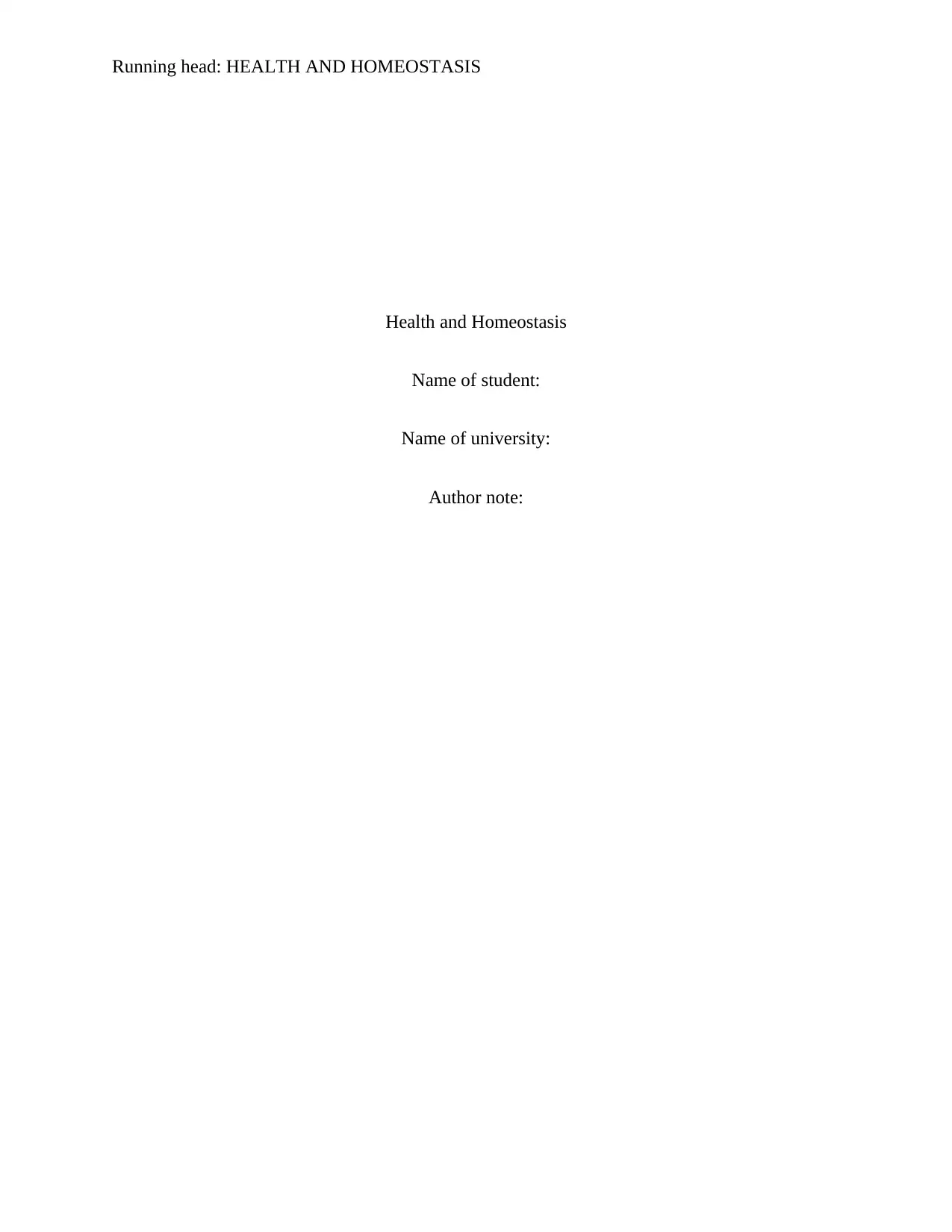
Running head: HEALTH AND HOMEOSTASIS
Health and Homeostasis
Name of student:
Name of university:
Author note:
Health and Homeostasis
Name of student:
Name of university:
Author note:
Paraphrase This Document
Need a fresh take? Get an instant paraphrase of this document with our AI Paraphraser
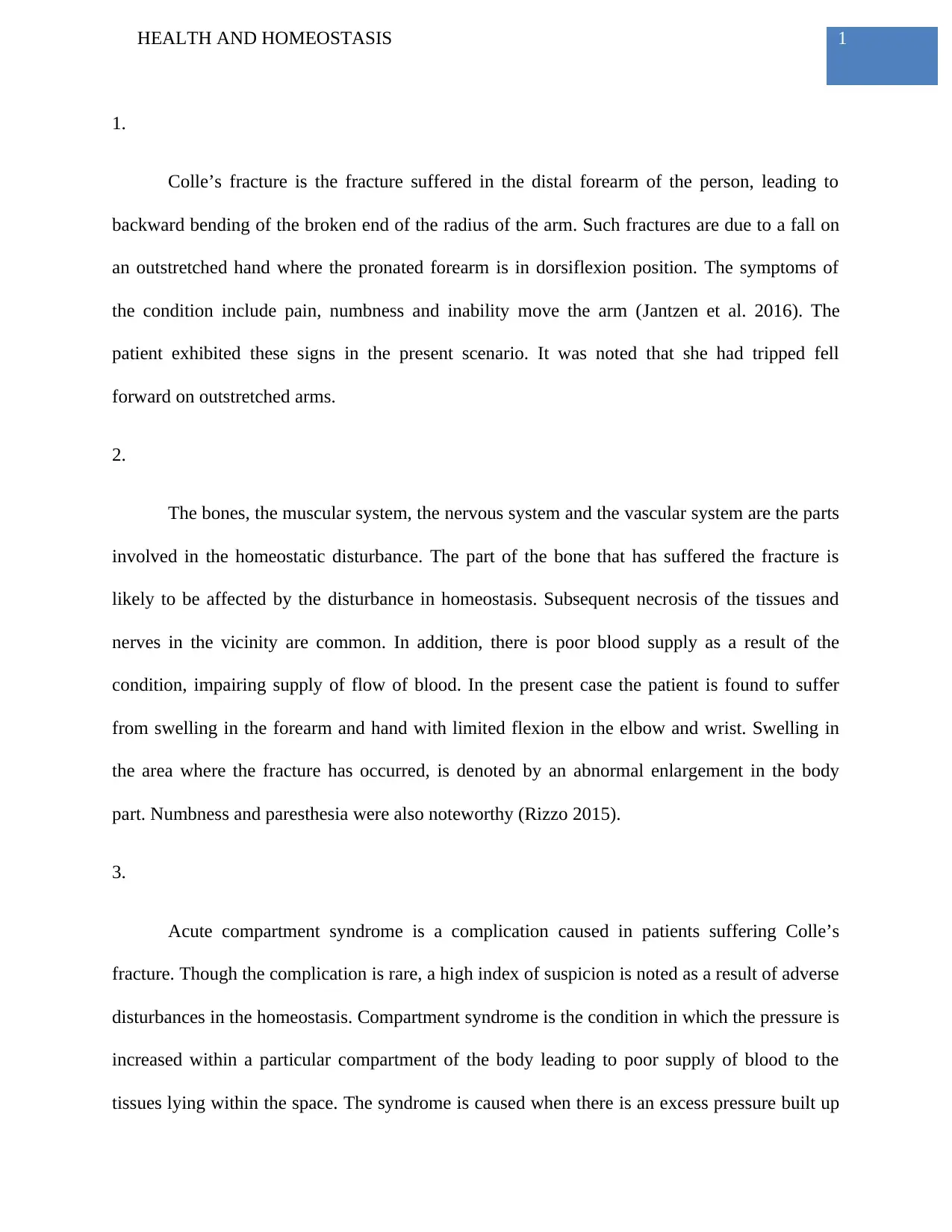
1HEALTH AND HOMEOSTASIS
1.
Colle’s fracture is the fracture suffered in the distal forearm of the person, leading to
backward bending of the broken end of the radius of the arm. Such fractures are due to a fall on
an outstretched hand where the pronated forearm is in dorsiflexion position. The symptoms of
the condition include pain, numbness and inability move the arm (Jantzen et al. 2016). The
patient exhibited these signs in the present scenario. It was noted that she had tripped fell
forward on outstretched arms.
2.
The bones, the muscular system, the nervous system and the vascular system are the parts
involved in the homeostatic disturbance. The part of the bone that has suffered the fracture is
likely to be affected by the disturbance in homeostasis. Subsequent necrosis of the tissues and
nerves in the vicinity are common. In addition, there is poor blood supply as a result of the
condition, impairing supply of flow of blood. In the present case the patient is found to suffer
from swelling in the forearm and hand with limited flexion in the elbow and wrist. Swelling in
the area where the fracture has occurred, is denoted by an abnormal enlargement in the body
part. Numbness and paresthesia were also noteworthy (Rizzo 2015).
3.
Acute compartment syndrome is a complication caused in patients suffering Colle’s
fracture. Though the complication is rare, a high index of suspicion is noted as a result of adverse
disturbances in the homeostasis. Compartment syndrome is the condition in which the pressure is
increased within a particular compartment of the body leading to poor supply of blood to the
tissues lying within the space. The syndrome is caused when there is an excess pressure built up
1.
Colle’s fracture is the fracture suffered in the distal forearm of the person, leading to
backward bending of the broken end of the radius of the arm. Such fractures are due to a fall on
an outstretched hand where the pronated forearm is in dorsiflexion position. The symptoms of
the condition include pain, numbness and inability move the arm (Jantzen et al. 2016). The
patient exhibited these signs in the present scenario. It was noted that she had tripped fell
forward on outstretched arms.
2.
The bones, the muscular system, the nervous system and the vascular system are the parts
involved in the homeostatic disturbance. The part of the bone that has suffered the fracture is
likely to be affected by the disturbance in homeostasis. Subsequent necrosis of the tissues and
nerves in the vicinity are common. In addition, there is poor blood supply as a result of the
condition, impairing supply of flow of blood. In the present case the patient is found to suffer
from swelling in the forearm and hand with limited flexion in the elbow and wrist. Swelling in
the area where the fracture has occurred, is denoted by an abnormal enlargement in the body
part. Numbness and paresthesia were also noteworthy (Rizzo 2015).
3.
Acute compartment syndrome is a complication caused in patients suffering Colle’s
fracture. Though the complication is rare, a high index of suspicion is noted as a result of adverse
disturbances in the homeostasis. Compartment syndrome is the condition in which the pressure is
increased within a particular compartment of the body leading to poor supply of blood to the
tissues lying within the space. The syndrome is caused when there is an excess pressure built up
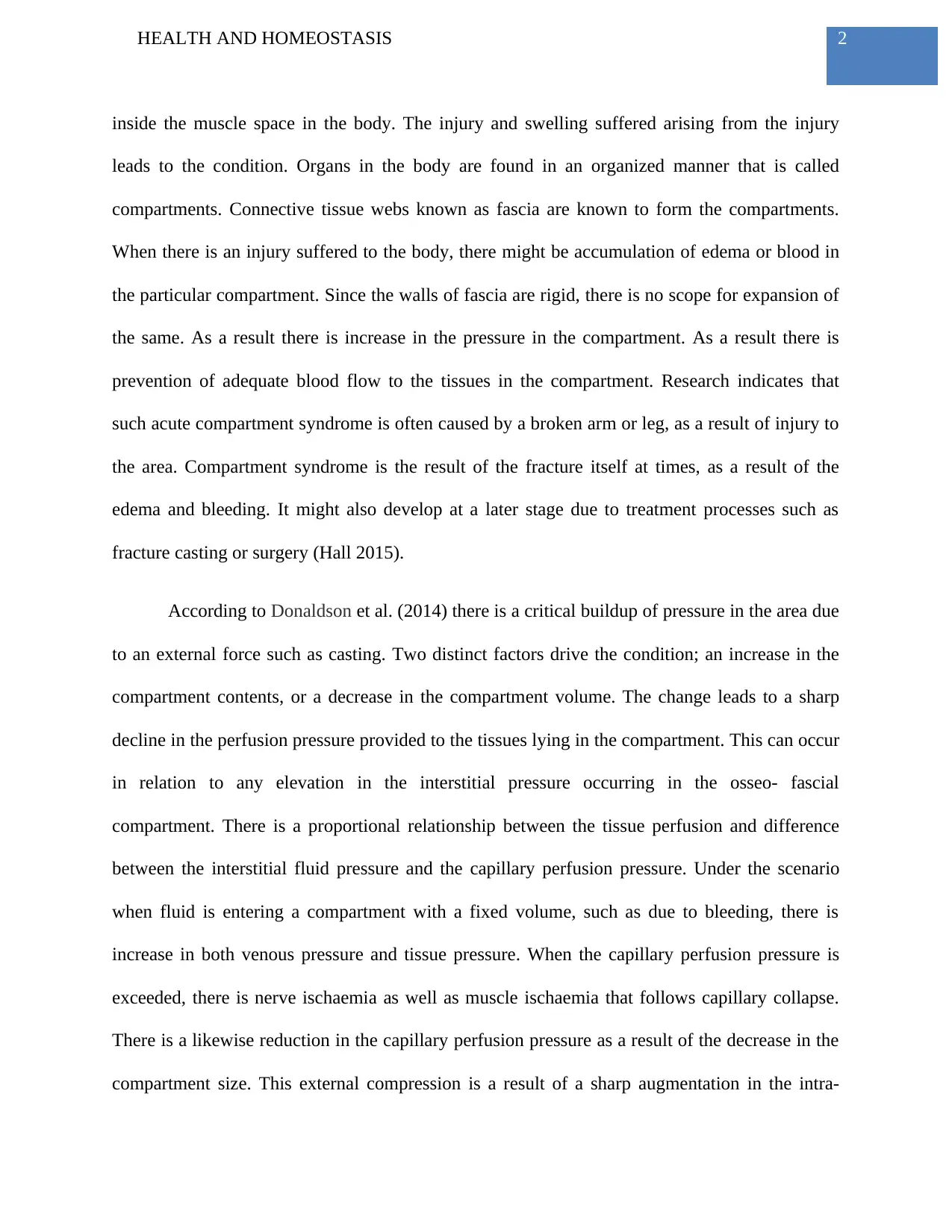
2HEALTH AND HOMEOSTASIS
inside the muscle space in the body. The injury and swelling suffered arising from the injury
leads to the condition. Organs in the body are found in an organized manner that is called
compartments. Connective tissue webs known as fascia are known to form the compartments.
When there is an injury suffered to the body, there might be accumulation of edema or blood in
the particular compartment. Since the walls of fascia are rigid, there is no scope for expansion of
the same. As a result there is increase in the pressure in the compartment. As a result there is
prevention of adequate blood flow to the tissues in the compartment. Research indicates that
such acute compartment syndrome is often caused by a broken arm or leg, as a result of injury to
the area. Compartment syndrome is the result of the fracture itself at times, as a result of the
edema and bleeding. It might also develop at a later stage due to treatment processes such as
fracture casting or surgery (Hall 2015).
According to Donaldson et al. (2014) there is a critical buildup of pressure in the area due
to an external force such as casting. Two distinct factors drive the condition; an increase in the
compartment contents, or a decrease in the compartment volume. The change leads to a sharp
decline in the perfusion pressure provided to the tissues lying in the compartment. This can occur
in relation to any elevation in the interstitial pressure occurring in the osseo- fascial
compartment. There is a proportional relationship between the tissue perfusion and difference
between the interstitial fluid pressure and the capillary perfusion pressure. Under the scenario
when fluid is entering a compartment with a fixed volume, such as due to bleeding, there is
increase in both venous pressure and tissue pressure. When the capillary perfusion pressure is
exceeded, there is nerve ischaemia as well as muscle ischaemia that follows capillary collapse.
There is a likewise reduction in the capillary perfusion pressure as a result of the decrease in the
compartment size. This external compression is a result of a sharp augmentation in the intra-
inside the muscle space in the body. The injury and swelling suffered arising from the injury
leads to the condition. Organs in the body are found in an organized manner that is called
compartments. Connective tissue webs known as fascia are known to form the compartments.
When there is an injury suffered to the body, there might be accumulation of edema or blood in
the particular compartment. Since the walls of fascia are rigid, there is no scope for expansion of
the same. As a result there is increase in the pressure in the compartment. As a result there is
prevention of adequate blood flow to the tissues in the compartment. Research indicates that
such acute compartment syndrome is often caused by a broken arm or leg, as a result of injury to
the area. Compartment syndrome is the result of the fracture itself at times, as a result of the
edema and bleeding. It might also develop at a later stage due to treatment processes such as
fracture casting or surgery (Hall 2015).
According to Donaldson et al. (2014) there is a critical buildup of pressure in the area due
to an external force such as casting. Two distinct factors drive the condition; an increase in the
compartment contents, or a decrease in the compartment volume. The change leads to a sharp
decline in the perfusion pressure provided to the tissues lying in the compartment. This can occur
in relation to any elevation in the interstitial pressure occurring in the osseo- fascial
compartment. There is a proportional relationship between the tissue perfusion and difference
between the interstitial fluid pressure and the capillary perfusion pressure. Under the scenario
when fluid is entering a compartment with a fixed volume, such as due to bleeding, there is
increase in both venous pressure and tissue pressure. When the capillary perfusion pressure is
exceeded, there is nerve ischaemia as well as muscle ischaemia that follows capillary collapse.
There is a likewise reduction in the capillary perfusion pressure as a result of the decrease in the
compartment size. This external compression is a result of a sharp augmentation in the intra-
⊘ This is a preview!⊘
Do you want full access?
Subscribe today to unlock all pages.

Trusted by 1+ million students worldwide
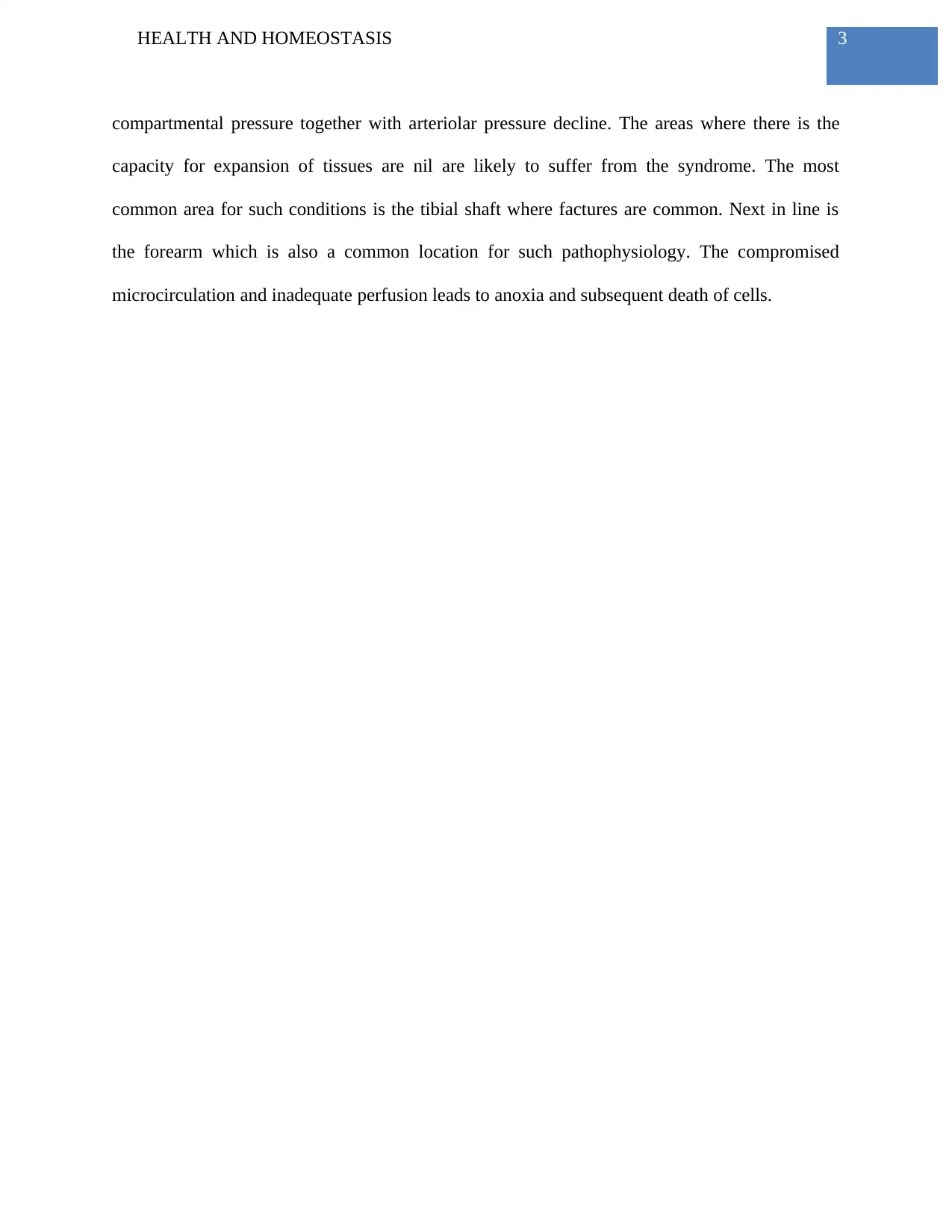
3HEALTH AND HOMEOSTASIS
compartmental pressure together with arteriolar pressure decline. The areas where there is the
capacity for expansion of tissues are nil are likely to suffer from the syndrome. The most
common area for such conditions is the tibial shaft where factures are common. Next in line is
the forearm which is also a common location for such pathophysiology. The compromised
microcirculation and inadequate perfusion leads to anoxia and subsequent death of cells.
compartmental pressure together with arteriolar pressure decline. The areas where there is the
capacity for expansion of tissues are nil are likely to suffer from the syndrome. The most
common area for such conditions is the tibial shaft where factures are common. Next in line is
the forearm which is also a common location for such pathophysiology. The compromised
microcirculation and inadequate perfusion leads to anoxia and subsequent death of cells.
Paraphrase This Document
Need a fresh take? Get an instant paraphrase of this document with our AI Paraphraser
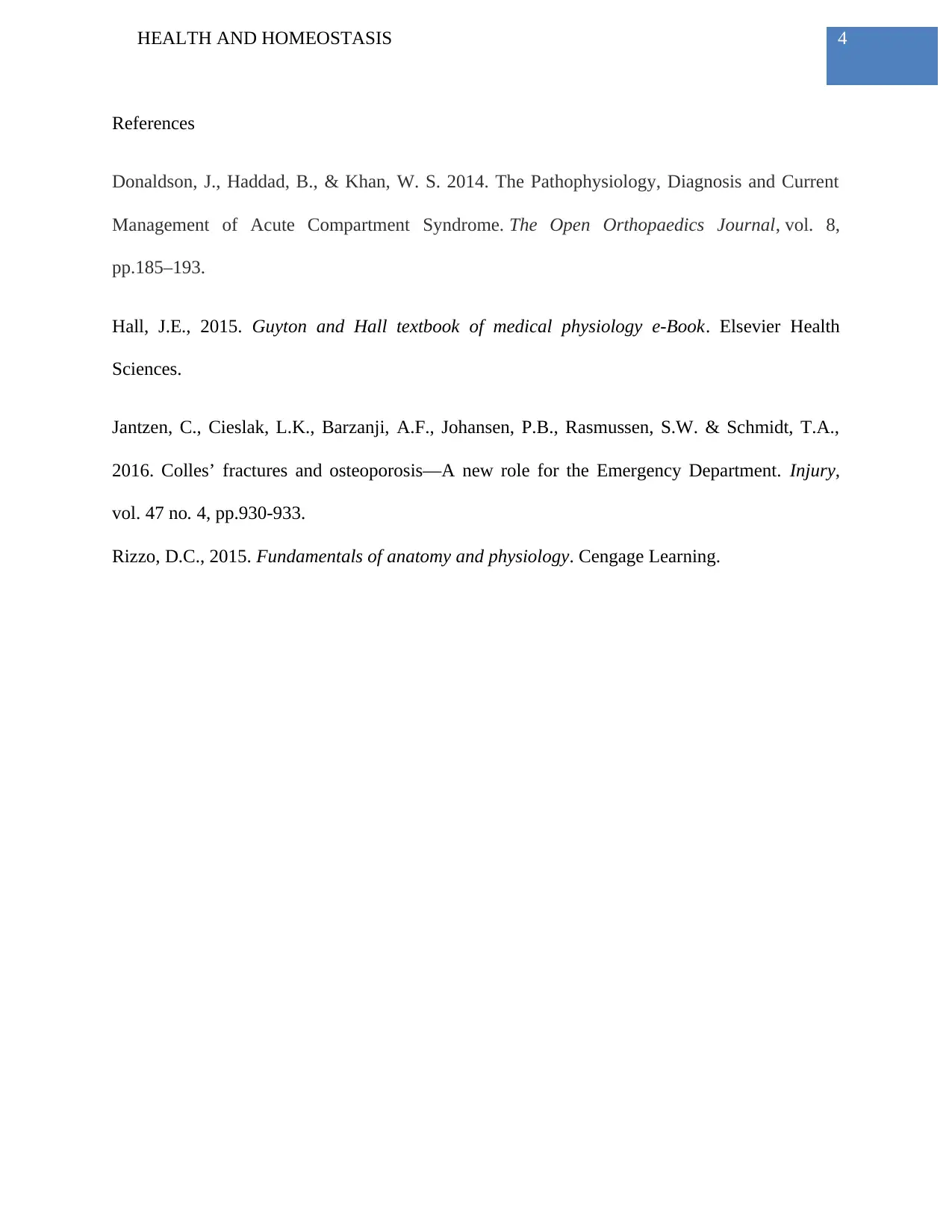
4HEALTH AND HOMEOSTASIS
References
Donaldson, J., Haddad, B., & Khan, W. S. 2014. The Pathophysiology, Diagnosis and Current
Management of Acute Compartment Syndrome. The Open Orthopaedics Journal, vol. 8,
pp.185–193.
Hall, J.E., 2015. Guyton and Hall textbook of medical physiology e-Book. Elsevier Health
Sciences.
Jantzen, C., Cieslak, L.K., Barzanji, A.F., Johansen, P.B., Rasmussen, S.W. & Schmidt, T.A.,
2016. Colles’ fractures and osteoporosis—A new role for the Emergency Department. Injury,
vol. 47 no. 4, pp.930-933.
Rizzo, D.C., 2015. Fundamentals of anatomy and physiology. Cengage Learning.
References
Donaldson, J., Haddad, B., & Khan, W. S. 2014. The Pathophysiology, Diagnosis and Current
Management of Acute Compartment Syndrome. The Open Orthopaedics Journal, vol. 8,
pp.185–193.
Hall, J.E., 2015. Guyton and Hall textbook of medical physiology e-Book. Elsevier Health
Sciences.
Jantzen, C., Cieslak, L.K., Barzanji, A.F., Johansen, P.B., Rasmussen, S.W. & Schmidt, T.A.,
2016. Colles’ fractures and osteoporosis—A new role for the Emergency Department. Injury,
vol. 47 no. 4, pp.930-933.
Rizzo, D.C., 2015. Fundamentals of anatomy and physiology. Cengage Learning.
1 out of 5
Related Documents
Your All-in-One AI-Powered Toolkit for Academic Success.
+13062052269
info@desklib.com
Available 24*7 on WhatsApp / Email
![[object Object]](/_next/static/media/star-bottom.7253800d.svg)
Unlock your academic potential
Copyright © 2020–2025 A2Z Services. All Rights Reserved. Developed and managed by ZUCOL.





